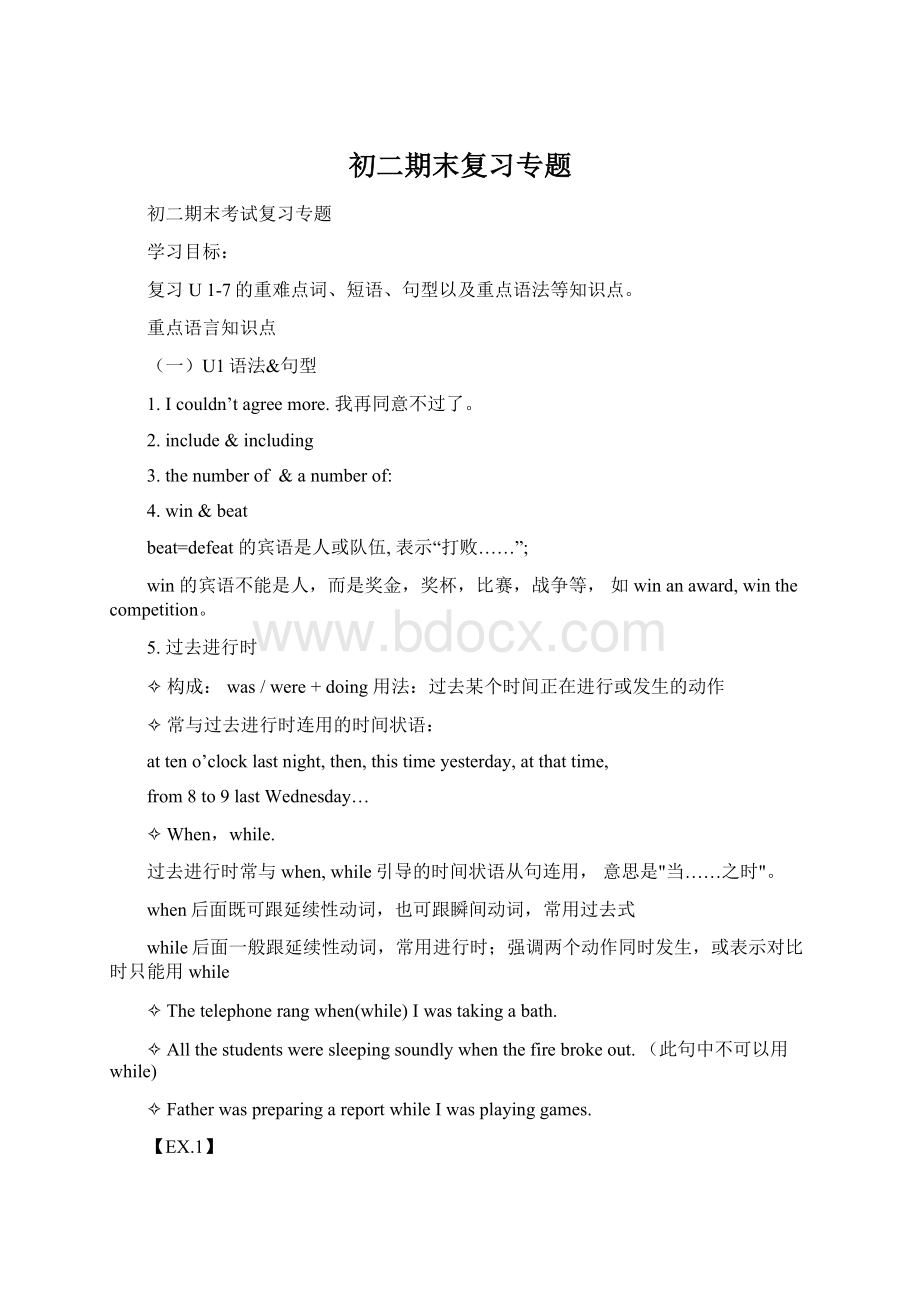初二期末复习专题.docx
《初二期末复习专题.docx》由会员分享,可在线阅读,更多相关《初二期末复习专题.docx(18页珍藏版)》请在冰豆网上搜索。

初二期末复习专题
初二期末考试复习专题
学习目标:
复习U1-7的重难点词、短语、句型以及重点语法等知识点。
重点语言知识点
(一)U1语法&句型
1.Icouldn’tagreemore.我再同意不过了。
2.include&including
3.thenumberof&anumberof:
4.win&beat
beat=defeat的宾语是人或队伍,表示“打败……”;
win的宾语不能是人,而是奖金,奖杯,比赛,战争等,如winanaward,winthecompetition。
5.过去进行时
✧构成:
was/were+doing用法:
过去某个时间正在进行或发生的动作
✧常与过去进行时连用的时间状语:
atteno’clocklastnight,then,thistimeyesterday,atthattime,
from8to9lastWednesday…
✧When,while.
过去进行时常与when,while引导的时间状语从句连用,意思是"当……之时"。
when后面既可跟延续性动词,也可跟瞬间动词,常用过去式
while后面一般跟延续性动词,常用进行时;强调两个动作同时发生,或表示对比时只能用while
✧Thetelephonerangwhen(while)Iwastakingabath.
✧Allthestudentsweresleepingsoundlywhenthefirebrokeout.(此句中不可以用while)
✧FatherwaspreparingareportwhileIwasplayinggames.
【EX.1】
1.We_______foryouat6:
00a.m.yesterday.D
A.waitB.waitedC.arewaitingD.werewaiting
2.Whilewe_______thepicnic,it_______torain.
A.arehaving;startedB.have;isstarting
C.werehaving;startedD.werehaving;wasstarting
3.Whenmybrotherreturnedlastnight,I______abook.
A.readB.amreadingC.wasreadingD.amgoingtoread
4.Ioften______theBritishMuseumwhileIwasstayinginLondon.
A.visitB.visitingC.visitedD.hadvisited
5.Thenumberofthestudentsinourclass___50.Andanumberofthem_____English.
A.are,areB.are,isC.is,areD.is,is
(二)U2语法&句型
1、形容词的一般用法
1)放在被修饰的名词前做定语:
acoldandwindyday;
2)放在连系动词后做表语:
feellonely;
常见的连系动词有:
a.be,keep,stay,appear,seem
b.感官动词:
look,sound,taste,smell,feel
c.表示“变得”:
grow,get,turn,become,fall,go
3)形容词修饰不定代词something,anyone,nobody等时,应放在不定代词的后面:
somethinginteresting
4)注意以下形容词加ly之后的区别:
wide(宽阔的)widely(广泛的):
fivemetreswide,widelyused;
deep(深度)deeply(深深的):
fivemetresdeep,deeplymoved;
hard(努力的/地)hardly(几乎不):
workhard,hardwork,hardunderstand
near(附近)nearly(几乎,大部分):
neartheschool,nearlyeveryone
5)只能做表语的形容词:
afraid,alone,asleep,awake,alive,well,ill,frightened;
6)ly结尾的形容词:
lonely,friendly,lively,lovely;
7)-ed(表示人或物的情绪、状态,表示被动)与-ing(表示人或物的特征、本质,表示主动)结尾的形容词的区别
2、Itis+adj.+(for/ofsb.)todosth形容词常表示事物的特征特点
Eg:
Itisnecessaryforthemtogetanelectriciantodotheworkforthem.
=Theyarenecessarytogetanelectriciantodotheworkforthem.
Itis+adj.+ofsb.todosth.形容词表示人物的内在评价(人的本质)。
Eg:
Itisverycleverofyoutoworkoutthemathprobleminsuchashorttime.
=Youareveryclevertoworkoutthemathprobleminsuchashorttime.
【EX.2】
1.Computerscanworkoutdifficultproblems________quicklythanhumanbeings.
A.verymoreB.morefarC.farmoreD.very
2.Thedressisverybeautiful,butitis________dear.
A.muchtooB.toomuchC.muchD.little
3.Looking________athismother,thelittleboylooked_______.
A.happy;goodB.happy;wellC.sadly;sadD.sad;sadly
4.The______boywastakentothenearesthospital.
A.illB.sickC.goodD.clever
5.Lucythinks_____isfun___hertolearnEnglish.
A.she,ofB.her,forC.it,toD.it,for
(三)U3语法&句型
1.both…and谓语复数
notonly…butalso,neither…nor,either…or就近原则
aswellas,with,alongwith与前面的名词保持一致
2.toomuch,muchtoo&toomany
3.trytodo&trydoing
4.make的用法使…成为…makesth./sb.+n.使…怎样/做某事makesth./sb.+adj./v.
5.seesbsthdoing&seesb/sthdo
6.noone&none
7.whether&if
8.so&such
9.语法重点:
直接引语变为间接引语,
把直接引语改为间接引语时,要注意以下变化:
1)确定连词&语序
✧陈述句:
(that)可以省略,语序不变。
主句的谓语动词可直接用引语中的said,也可用told来代替,注意,可以说saidthat,saidtosb.that,toldsb.that,不可直接说toldthat
✧一般疑问句:
if/whether,语序是陈述句的语序
原主句中谓语动词said要改为asked(me/him/us等),
Hesaid,“Doyouhaveanydifficultywithpronunciation?
”
→Heasked(me)whether/ifIhadanydifficultywithmypronunciation.
✧特殊疑问句:
使用原句疑问词when,where,who等,语序改为陈述句语序
主句的谓语动词用ask(sb.)来表达
✧祈使句:
把句子改为以下句式:
ask/tell/ordersb.(not)todosth.
2)转换人称
根据情况做相应的改变,“一随主,二随宾,三不变”
主格:
Iyouhesheitwethey
宾格:
meyouhimheritusthem
形容词:
myyourhisheritsourtheir
名词性物主代词:
mineyourshishersitsourstheirs
反身代词:
myselfyourselfhimselfherselfourselvesyourselvesthemselves
3)时态的转变
主句:
现在时或将来时,从句:
不变
Shesays,“I’llneverforgetthedaysinthecountry.”
Shesaysthatshe’llneverforgetthedaysinthecountry.
主句:
过去时,从句:
对应的过去时态
从句中是真理性的时态不变
Thegeographyteachersaid,“Thesunrisesintheeastandsetsinthewest.”
→Thegeographyteachertoldusthatthesunrisesintheeastandsetsinthewest.
主句是过去时,从句的时态变化
直接引语
间接引语
一般现在时
am/is/aredo/does
一般过去时
was/were
did
现在进行时
am/is/aredoing
过去进行时
was/weredoing
现在完成时
have/hasdone
过去完成时
had+done
一般过去时
was/weredid
一般过去时
过去完成时
was/were/did
had+done
一般将来时
am/is/aregoingtodo
willdo
过去将来时
was/weregoingtodo
woulddo
4)指示代词和时间状语的变化
this-----thatthese-----thosehere-----there
now-----thentoday-----thatdaytonight---thatnight
tomorrow-----thenextday/the